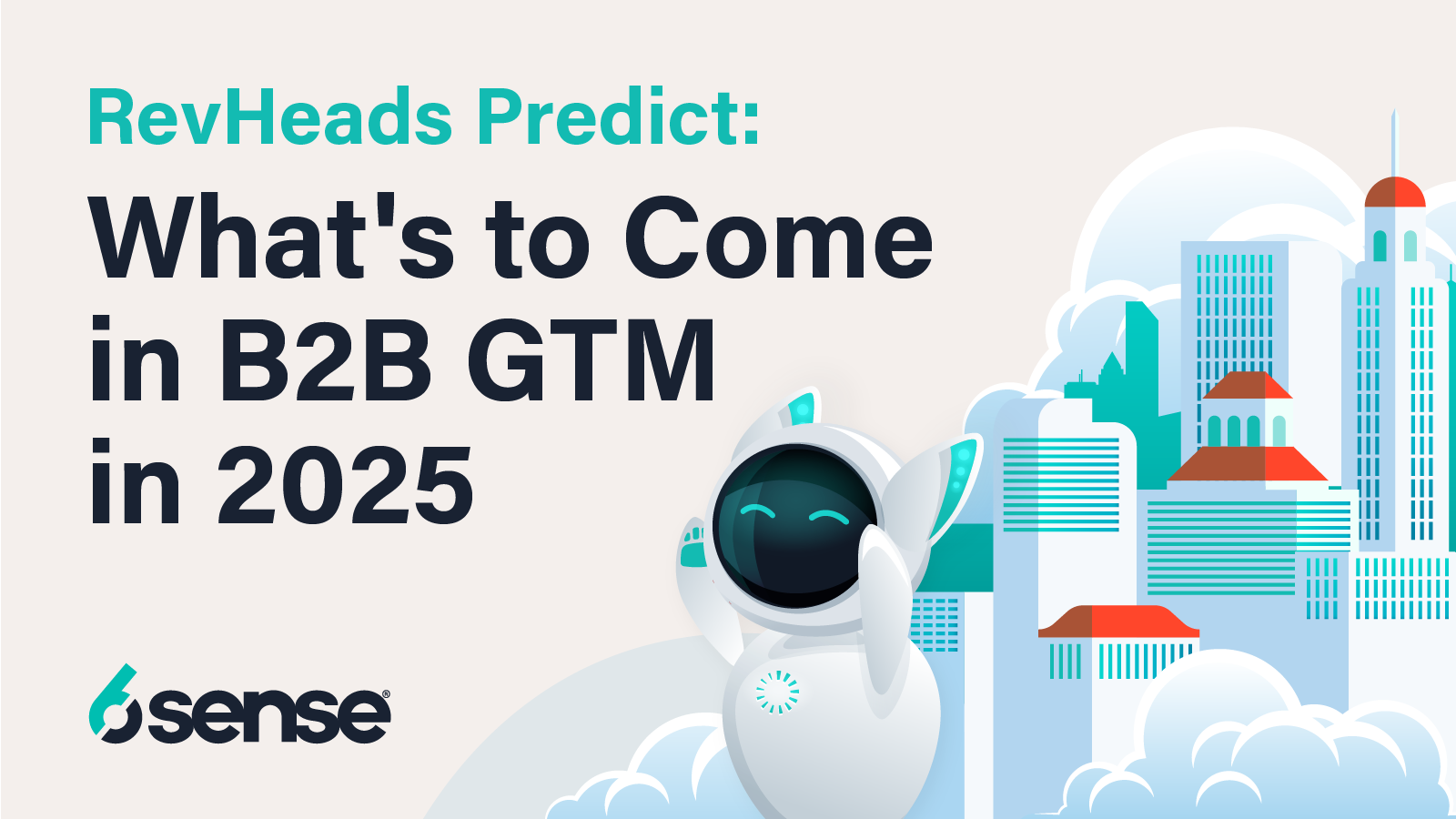At 6sense we know a thing or two about predictions. Every day, thousands of B2B companies trust 6sense to power their pipeline through our data and AI. 6sense customers are at the cutting edge of revenue generation, so when it came to thinking about predictions for 2025, we thought, “Why not turn to our customers and community of 10,000+ RevHeads and counting, to hear what they have to say?”
Here are some predictions from industry leaders — the people doing the work, trying to hit audacious revenue targets quarter after quarter — for what’s to come in B2B GTM in 2025.
Liza Adams, AI & Exec Advisor, Fractional CMO – GrowthPath Partners

The most sought-after GTM leaders won’t be the ones who know AI best. They’ll be the ones who master five critical areas that AI makes more urgent than ever. Those who do will speed up success. Those who don’t will fail faster.
The five critical areas are:
1) Understanding how AI changes buyer behavior and adapting,
2) Moving past surface-level AI use,
3) Mastering the connection between trust and product-market fit,
4) Leading as business growth drivers, not just functional experts, and
5) Driving change with empathy.
Liza goes into detail about each of the five critical areas in her LinkedIn post.
Jonathan Burg, SVP, Revenue – New Breed

There will be a shift from AI being focused on content creation to content quality and data insights.
In the State of HubSpot report we saw a shift in what organizations expect the biggest impact to be from AI. In 2024 it was all about content creation. Moving into 2025 revenue leaders are looking to AI to support data analysis and Insights and content quality. We are seeing a shift where people think about AI as a collaborator, rather than a creator. It can help with brainstorming, identifying trends, and streamlining workflows. This frees up time for people to focus on storytelling, tone, and innovative ideas, blending the efficiency of AI with human ingenuity.
With changes in search engine algorithms (e.g., Google’s E-E-A-T framework emphasizing expertise and trustworthiness), AI is used to optimize content for these standards. It ensures alignment with evolving digital landscapes while maintaining authenticity.
Investments like HubSpot’s recent acquisition of Frame AI speak to AI’s strength in analyzing user behavior and audience data to inform content strategies. This enables more tailored and meaningful connections, ensuring content resonates with specific audience segments. These kinds of capabilities will deliver real-time analysis of customer interactions across multiple channels, providing deeper contextual insights and actionable intelligence.
Adam Kite, Vice President Brand, Content & Operations – RELEX Solutions

The biggest macro trend I see emerging in 2025 will be the rise in prospect expectation for highly personalised digital experiences. This will be driven mainly by how information is made available to us via GPTs, which is highly personalised and represents a shift in searching for knowledge to directly searching for answers from an AI agent.
The next development will be the integration of AI agents. We’ve seen tech vendors begin to design, train, and deploy their own AI agents over the past couple of years. In 2025, I think we’ll start to see more vendors experiment with how their agents can integrate with other agents. Additionally, we may see new software companies emerge that will serve as platforms for AI agent collaboration.
Christopher Lynch, CMO – SOVOS

“Allbound” will become the rule. The first phase of Account-based Marketing (ABM) in B2B was predicated on the idea of “don’t bother targeting these accounts here, marketing team; focus on these accounts here.” That’s because intent models highlighted the accounts in “decision” and “purchase.” This represented a massive shift from regular demand gen, where the idea was to generate and work inbound leads, even if they sometimes fell outside your ideal customer profile (ICP).
B2B marketers felt empowered and excited by the shift, but two realities hit them hard the last couple of years. For one, privacy changes in many geos made the extent to what we know about individuals at these accounts more limited. That’s no fault of any vendors or service providers; it’s just a shift many governments undertook. Two, many companies realized that the addressable market would be too small if they only focused on mid-to-late stage buyers. Just look at 2022-2023 — it wasn’t a great year for marketing-generated pipeline for many companies. In 2025, I think ABM will grow up more; it will extend its reach even further in the outbound engine of sales and sales development organizations. Those organizations will become power users, and align it with the accounts marketing is driving inbound efforts against.
The lines between outbound and inbound have been blurring for years, but I think 2025 will the year of “allbound,” which is a term I hear marketers using more and more now. Every time I’ve gone to a pipeline meeting where people are hashing out how much marketing will source versus sales, my first response is, “no one ever cares about this if we hit 100% of our coverage goals.” So the more that fence between inbound and outbound drops, the healthier your GTM strategy will be.
Dina Otero, Vice President, Demand Generation – Mission Cloud

In 2025, brand and demand generation teams will be more closely connected as businesses use branding to boost their demand efforts. Previously, my colleague and I referred to ourselves as “Debrand Gen” professionals.
A strong brand identity creates interest from the start of the sales process, which is crucial for attracting leads. When a brand aligns with its audience’s values, engagement increases, easing the transition from awareness to consideration. Effective branding also builds trust and credibility, which can shorten sales cycles since customers tend to commit to brands they recognize and trust.
The demand generation team should also provide brands with insight into public reactions to advertisements, including display ads, SEO, and targeted events. Without this data, it’s challenging to innovate future campaigns. While brands have their own metrics, collaborating with the demand team for feedback on what resonates is more impactful.
Sarah Sehgal, Director, Growth Marketing – OpenSesame

Content is (still) King, distribution is (still) Queen… but AI is the new Royal Advisor.
AI will turbocharge content creation and distribution in 2025: streamlining workflows, repurposing assets, and making distribution way more precise. But the temptation to use it to shortcut everything will make or break marketing teams (and their audiences). The teams that deeply understand their audience, nail their product-market fit, and craft real stories around that will sprint past the teams just churning out AI noise.
Sydney Sloan, CMO – G2

While we would all love to see the end of cold spammy emails, I predict we will start seeing improvements! We’re seeing better use of intent signals and the adoption of AI agents to create more relevant and, frankly, better-written outbound. While nearly all go-to-market teams leveraged AI platforms and AI-powered products in 2024, only some began to embrace agents. These will take off in 2025, and the BDR of the future will arrive on the scene.
The teams that ensure their agents are ingesting the most accurate and impactful data — including specific types of buyer intent signals — will stand out from the pack. The result of this new approach will be a lower volume of sales and marketing outreach with higher conversion. I’m really looking forward to seeing these improvements and the ability of these agents to be trained and respond intelligently. No more nurtures, only conversations!


